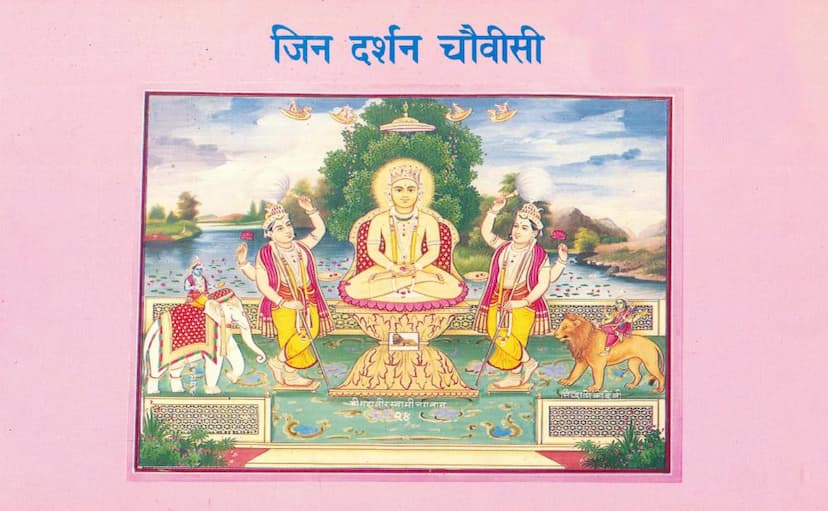Jin Darshan Chovisi
Added to library: September 2, 2025

Summary
Here's a comprehensive summary of the Jain text "Jin Darshan Chovisi" based on the provided pages:
Book Title: Jin Darshan Chovisi (Compilation of Twenty-Four Tirthankaras) Author(s): Prakrit Bharti Academy (Publisher) Publisher: Prakrit Bharti Academy, Jaipur Catalog Link: https://jainqq.org/explore/004352/1
Overall Purpose and Content:
"Jin Darshan Chovisi" is a Jain religious and artistic publication by Prakrit Bharti Academy. It presents a collection of beautifully rendered, colored illustrations of the twenty-four Tirthankaras of Jainism. The book aims to provide a visually appealing and informative guide to these revered spiritual leaders, accompanied by relevant scriptural details.
Key Features and Content Breakdown:
- Artistic Merit: The book is highlighted for its "excellent colored pictures in the Jaipur style." These paintings were created by the renowned Jaipur Palace artist, Shri Badrinarayanji, approximately 55-60 years prior to the publication's first edition. The artistic quality is emphasized as a significant aspect of the work.
- Scriptural Accuracy: The paintings were executed under the consultation and supervision of the esteemed Jain scholar, Pandit Bhagwandasji Jain, who was an authority on Jain architecture, sculpture, painting, and astrology in Jaipur at that time. This ensures that the depiction of each Tirthankara adheres to scriptural norms.
- Detailed Depictions: Each Tirthankara's image is characterized by:
- Ashta Mahapratiharyas: The eight auspicious symbols.
- Varna (Color): The characteristic complexion.
- Lanchhana (Emblem): The symbolic emblem associated with each Tirthankara.
- Shasan Dev-Devis: The guardian deities (Yakshas and Yakshinis) are depicted on either side of the main image, also presented in a classical style with their respective colors, forms, and weapons.
- 25th Image: The twenty-fifth picture is dedicated to Gautam Swami, the chief disciple and Ganadhar of Lord Mahavir, who is described as the "repository of all perfections." The four cardinal directions around Gautam Swami's image feature goddesses: Saraswati, Tribhuvan Swamini, Lakshmi, and the Yaksha Ganapithaka.
- Historical Context and Revival:
- The original artworks were gifted by the artist, Badrinarayanji, to Pandit Bhagwandasji Jain.
- Pandit Bhagwandasji first published these paintings in 1939 (Veer Samvat 2466, Vikram Samvat 1996) under the title "Adarsh Jain Darshan Chovisi aur Ananupurvi."
- The first edition was highly appreciated and quickly became unavailable.
- Prakrit Bharti Academy expressed a long-standing desire to re-publish this artistic "Chovisi."
- After considerable effort to locate the original blocks and paintings, they learned that the original artworks had been purchased by Acharya Shri Vijay Yashodev Suriji from Pandit Bhagwandasji Jain about 50 years prior and were safely in his possession.
- Acharya Shri Vijay Yashodev Suriji graciously provided transparencies of the paintings and gave his approval and blessings for the re-publication. This act of generosity by Acharya Shri is greatly acknowledged.
- The publication was made possible through the efforts of Shri Ravindra Kumarji Singhvi and his wife, Smt. Amila Singhvi, along with the support of Saubhagya Advertising Co., Delhi.
- Detailed Information for Each Tirthankara (Pages 16-82): For each of the 24 Tirthankaras, the book provides:
- A Sanskrit stotra (praise verse) dedicated to them.
- Their name and a brief descriptive epithet.
- Pūrvabhav Sankhya: The number of past lives.
- Chyavan Sthan: The celestial abode from which they descended.
- Chyavan Tithi: The date of their descent into the womb.
- Janma Nagari: Birthplace.
- Janma Tithi: Date of birth.
- Vansh: Dynasty.
- Pitri Naam: Father's name.
- Matri Naam: Mother's name.
- Janma Nakshatra: Birth star.
- Janma Rashi: Birth zodiac sign.
- Lanchhana: Emblem.
- Varna: Color.
- Diksha Nagari: Place of renunciation.
- Diksha Tithi: Date of renunciation.
- Chhadmasth Kaal: Period of worldly existence before omniscience.
- Gyaan Nagari: Place of attaining omniscience.
- Gyaan Tithi: Date of attaining omniscience.
- Ganadhar Sankhya: Number of chief disciples.
- Ganadhar Naam: Name of the chief Ganadhar.
- Moksha Sthan: Place of liberation.
- Moksha Tithi: Date of liberation.
- Yaksh Naam: Name of the guardian Yaksha.
- Yakshini Naam: Name of the guardian Yakshini.
- Pramukh Tirth: Important pilgrimage sites associated with the Tirthankara.
- Ananupurvi (Sequential Recitation): Page 23 provides instructions on how to perform "Ananupurvi" recitation, linking the numbers 1 to 5 to specific Navkaravali mantras (e.g., Namo Arihantanam, Namo Siddhanam, etc.). It also states the spiritual benefit of this practice, equating it to a "chhamasi tapas" (six-month penance) and the destruction of lifespans in hell.
- About Acharya Yashodev Suriji's Role: Acharya Yashodev Suriji narrates his personal connection to the artwork, how he first encountered it, his appreciation for its artistic quality, and his eventual purchase and preservation of the original paintings, which he later made available for this republication. He mentions his own desire to publish the "Darshan Chovisi" and his unfulfilled dreams of establishing a grand Jain museum and library.
- Publisher's Gratitude: The publication expresses deep gratitude to Acharya Shri Vijay Yashodev Suriji for his magnanimity and to Shri Ravindra Kumarji Singhvi and Smt. Amila Singhvi for their instrumental support in making the publication a reality.
In essence, "Jin Darshan Chovisi" is a significant re-publication of a historically important and artistically valuable collection of Jain Tirthankara paintings. It serves as both a devotional resource, offering detailed scriptural information about each Tirthankara, and a testament to the rich artistic heritage of Jainism, particularly the Jaipur school of art.